Goat Cheese Market Research, 2032
Global goat cheese market was valued at $6.0 billion in 2022, and is projected to reach $9.2 billion by 2032, growing at a CAGR of 4.5% from 2023 to 2032.The growing interest in artisanal and specialty foods has boosted demand for goat cheese. The unique tangy flavor, creamy texture, and perceived health benefits of goat cheese have attracted consumers seeking diverse culinary experiences. In addition, dietary trends emphasizing natural, locally sourced products have driven the popularity of goat cheese, as it aligns with preferences for sustainable and ethically produced food options.
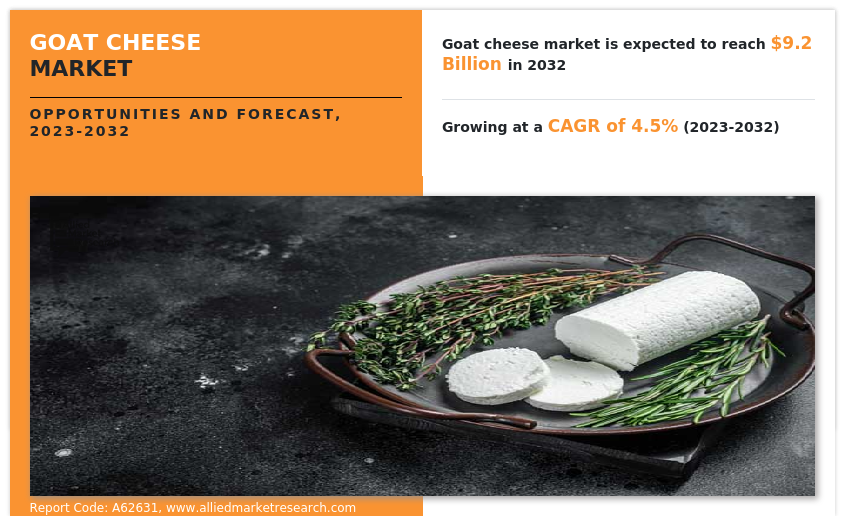
Goat cheese is a type of cheese made from goat milk. Fresh goat milk is first heated to make goat cheese, followed by the addition of an acidifying agent, such as lemon juice or vinegar, to curdle the milk. The curds are then drained and often pressed to remove excess whey. The resulting curds are molded into various shapes and sizes, and sometimes aged for different periods to develop distinct flavors and textures. Goat cheese can range from soft and spreadable to firm and crumbly, with a tangy flavor profile. Goat cheese is a versatile cheese used in various culinary applications, including salads, sandwiches, and appetizers.
Key Takeaways of Goat Cheese Market Report
- By type, the fresh cheese segment was the highest revenue contributor to the market in 2022 owing to the nutritional benefits, such as lower fat and cholesterol compared to cow's cheese.
- As per flavor, the tangy and tart segment was the largest segment in the global goat cheese market during the forecast period.
- Depending on distribution channel, the supermarkets/hypermarkets segment was the largest segment in 2022.
- Region-wise, Europe was the highest revenue contributor in 2022 owing to the fertile pastures and mild climates, which creates ideal conditions for dairy farming and cheese production.
Market Dynamics
Increase in demand for lactose free cheese products
The preference for goat cheese among lactose-intolerant individuals has significantly boosted demand for the goat cheese market. According to the American College of Gastroenterology, approximately 15% of adult Caucasians and 85% of adult African Americans in the U.S. are lactose intolerant, with similarly high rates observed among individuals of Asian descent, Hispanic descent, Native Americans, and Jewish individuals. Goat cheese contains lower levels of lactose compared to cow's milk cheese, making it more digestible for those with lactose intolerance. As awareness of lactose intolerance increases and more consumers seek alternatives to traditional dairy products, the goat cheese market demand has grown in recent years.
Moreover, goat cheese offers a rich and creamy flavor profile that matches its cow's milk counterparts, making it convenient option for consumers looking for lactose-free alternatives with a similar taste and texture. This has led to an expansion of the goat cheese market, with manufacturers meeting the growing demand by offering a wide range of goat cheese varieties, from soft and spreadable to firm and aged. As a result, the preference for goat cheese among lactose-intolerant individuals has driven market growth and contributed to the diversification and innovation within the goat cheese industry, which further establishes its position in the global dairy market and results in increase of goat cheese market share.
Competition from other specialty cheese
The rise in competition from other specialty cheeses available in the market has led to a significant restraint on the market demand for goat cheese during the goat cheese market forecast. While goat cheese offers unique flavor profiles and nutritional benefits, it faces stiff competition from a wide range of specialty cheeses, including cow milk cheeses such as Brie, Camembert, and Gouda, as well as other artisanal cheeses such as blue cheese, feta, and aged cheddar. These cheeses often have established consumer bases and strong brand recognition, making it challenging for goat cheese to capture market share, particularly among consumers who are in a regular habit to purchasing these familiar varieties.
Furthermore, the penetration of gourmet and artisanal cheese offerings in the market intensifies competition for shelf space and consumer attention. Cheeses with distinct flavor profiles and regional specialties may attract consumers seeking novelty and variety, further diverting attention away from goat cheese. In addition, some consumers may perceive goat cheese as an acquired taste or niche product, opting for more mainstream cheese options instead. As a result, goat cheese may struggle to gain traction in a crowded market landscape, hindering its market demand and limiting the goat cheese market growth potential.
Introduction of organic and premium-grade goat cheese
The introduction of organic and premium-grade goat cheese options has significantly expanded opportunities within the goat cheese market, particularly in regions where such offerings were previously limited or nonexistent. By catering to consumers seeking healthier and higher-quality food choices, producers of organic and premium-grade goat cheese have tapped into a growing niche market, thus resulting in increase of goat cheese market size. This diversification has enhanced the overall demand for goat cheese along with attracting a broader customer base, including health-conscious individuals, food enthusiasts, and those with dietary restrictions such as lactose intolerance.
Moreover, the availability of organic and premium-grade goat cheese options has spurred innovation and competition within the industry. Producers are increasingly investing in sustainable farming practices, ensuring the quality and purity of their products while also meeting the demands of environmentally conscious consumers. In addition, the expansion of distribution networks and online platforms has facilitated greater accessibility to these specialty goat cheese varieties, reaching customers beyond traditional market boundaries. This strategic approach to product development and marketing has allowed companies to boost sales and increase the status of goat cheese as a versatile and desirable culinary choice worldwide. As a result, the goat cheese market continues to thrive, driven by a combination of consumer preferences for healthier and premium food options and the commitment of the industry to quality and sustainability.
Segmental Overview
The goat cheese market is segmented into Type, Flavor and Distribution Channels.
By Type
By type, the fresh cheese segment dominated the global goat cheese market in 2022 and is anticipated to maintain its dominance during the forecast period. Fresh goat cheese offers a distinctively tangy and creamy flavor profile that appeals to a wide range of consumers, from culinary enthusiasts to health-conscious individuals. The versatility of goat cheese in various culinary applications, including salads, pastas, and spreads, has further boosted its popularity. In addition, the perception of freshness and purity associated with this segment aligns with contemporary consumer preferences for natural and minimally processed foods. Moreover, the rise in awareness of the nutritional benefits of goat cheese, such as being lower in fat and cholesterol compared to cow's cheese, has driven demand for fresh goat cheese as a healthier alternative. Furthermore, the ease of production and relatively shorter ageing process required, allowing for quicker turnover and fresher products on the market, has increased the market share of this segment.
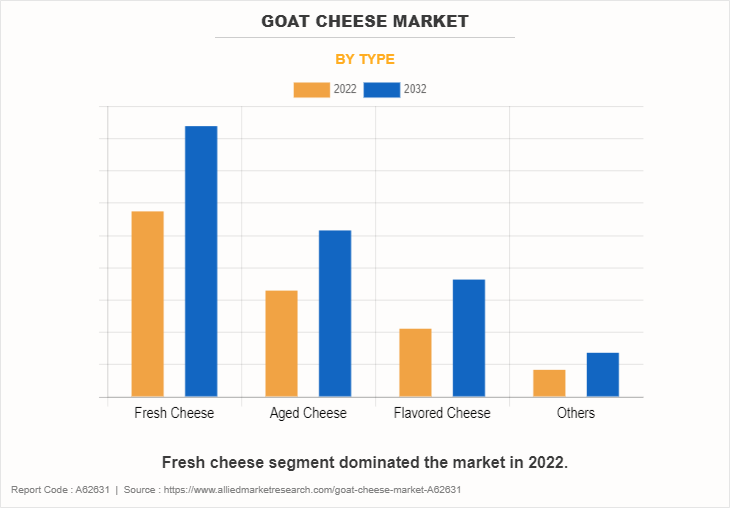
By Flavor
By flavor, the tangy and tart segment dominated the global goat cheese market in 2022 and is anticipated to maintain its dominance during the forecast period. Characterized by its distinctive tanginess and subtle tartness, this flavor profile offers a refreshing and palate-stimulating experience that sets it apart from other goat cheese varieties. The tangy and tart notes complement a variety of dishes, ranging from salads and sandwiches to pasta and pizzas, making it a versatile ingredient in both savory and sweet culinary creations.
Furthermore, the tangy and tart flavor segment aligns well with the growing demand for bold and different unique flavors in the food industry, catering to consumers seeking innovative taste experiences. As a result, producers have responded by expanding their offerings within this segment, introducing new flavor variations and product formulations to meet evolving consumer preferences. With its widespread appeal and versatility, the tangy and tart flavor segment continues to drive growth and innovation in the goat cheese market.
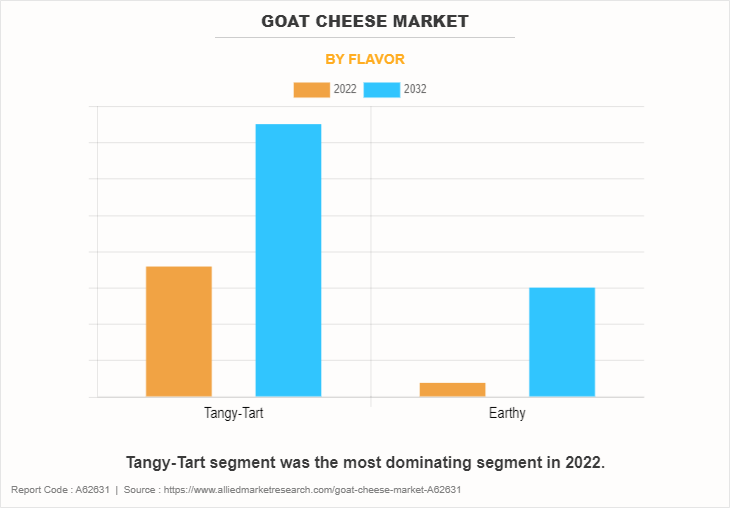
By Distribution Channel
By distribution channel, the supermarkets/hypermarkets segment dominated the global goat cheese market in 2022. Consumers prefer purchasing goat cheese from supermarkets and hypermarkets owing to convenience, variety, and accessibility, these retail environments offer in recent times. Supermarkets and hypermarkets typically provide a one-stop shopping experience, allowing consumers to easily find a diverse selection of goat cheese brands, flavors, and formulations in one location. The extensive shelf space and strategic product placement in these stores enhance visibility, enabling consumers to explore different options. Furthermore, ability to compare prices, read product labels, and take advantage of promotional offers contributes to the appeal of purchasing goat cheese in supermarkets and hypermarkets, making it a convenient and efficient choice for consumers seeking quality and authentic goat cheese.
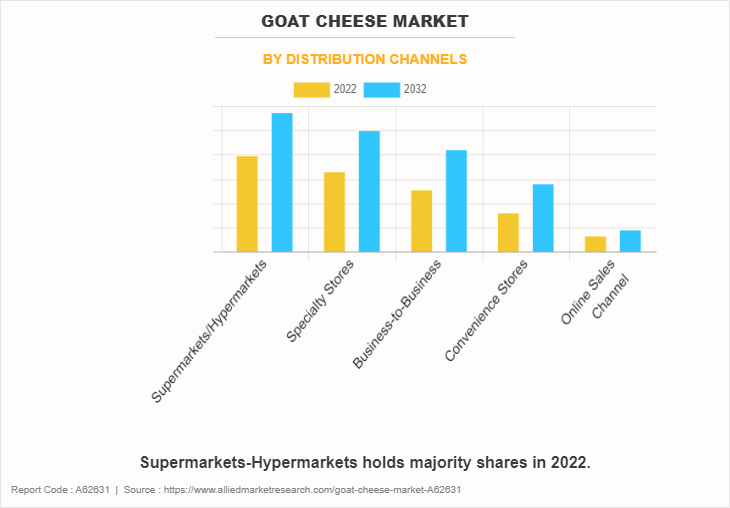
By Region
Region-wise, Europe is anticipated to dominate the market with the largest share during the forecast period. Europe has a rich tradition of cheese-making, with centuries-old artisanal practices that have been passed down through generations. This heritage has led to the development of a diverse range of goat cheese varieties, each showcasing unique flavors, textures, and characteristics, which appeal to consumers both domestically and internationally. In addition, Europe benefits from favorable geographical conditions and abundant resources, such as fertile pastures and mild climates, which are ideal for dairy farming and goat cheese production. The suitable climate has allowed European goat cheese producers to maintain high standards of quality and consistency in their products, further enhancing their reputation and market competitiveness.
Furthermore, the strong culinary culture and gastronomic heritage of Europe play a significant role in driving demand for goat cheese within the region. Goat cheese is a staple ingredient in many European cuisines, featuring prominently in dishes ranging from salads and appetizers to main courses and desserts. This widespread culinary appreciation promotes a robust domestic market for goat cheese consumption while also fueling export opportunities to other regions around the world. Moreover, Europe's well-established distribution networks and infrastructure facilitate the efficient transportation and marketing of goat cheese products, enabling European producers to reach a broad customer base across domestic and international markets.
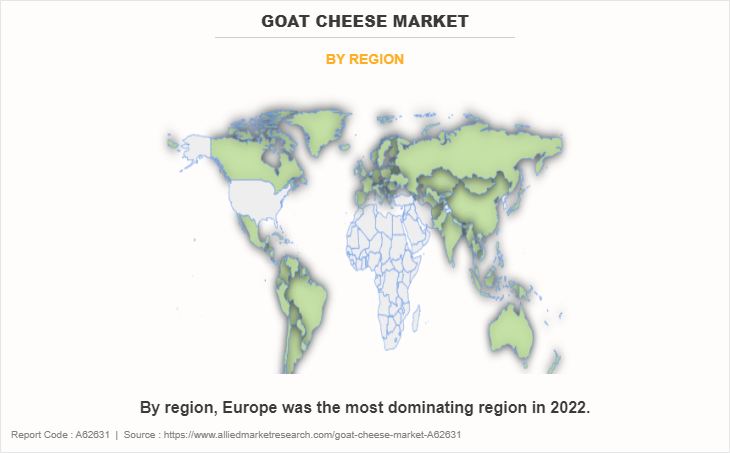
Competitive Analysis
Key players include Laura Chenel‐™s Chevre, Inc., Haystack Mountain Creamery, Saputo Inc., Belle Chevre Inc., Vermont Creamery, Cypress Grove Chevre, Inc., Capriole, Inc., Redwood Hill Farm & Creamery, St Helen's Farm Ltd., DeJong Cheese, and Amsterdam Cheese Company.
Several well-known and upcoming brands are vying for market dominance in the expanding goat cheese industry. Smaller, niche firms are more well-known for catering to consumer demands and tastes. Large conglomerates, however, control most of the market and often buy creative start-ups to broaden their product lines.
Private label brands created by merchants and e-commerce platforms are another aspect of the competitive market. While they provide more affordable options, they have different recognition or range of products than well-known companies. An important competition component is innovation in formulations, ingredient sourcing, and sustainability policies. Brands that change the tastes of their target market and align with their ethical & environmental values have an advantage over rivals.
Recent Developments in Goat Cheese Market
- In August 2022, Saputo Cheese USA Inc. launched new offerings under the Montchevre brand, including a Hibiscus Berry Goat Cheese Log and a range of Topped Goat Cheeses to provide unique snacking options that satisfy evolving consumer preferences for distinctive flavors.
- In May 2021, Laura Chenel introduced their new goat cheese creation, the Everything Bagel Chabis. This fresh, creamy cheese is infused with a blend of sesame seeds, garlic, poppy seeds, and onion, to attract consumers seeking innovative taste experiences.
- In April 2021, Old Amsterdam expanded its aged gouda line with two new flavors, namely, Old Amsterdam Mild and Old Amsterdam Reserve to strengthen their product portfolio.
Key Benefits for Stakeholders
- This report provides a quantitative analysis of the market segments, current trends, estimations, and dynamics of the goat cheese market analysis from 2022 to 2032 to identify the prevailing goat cheese market opportunities.
- The market research is offered along with information related to key drivers, restraints, and opportunities.
- Porter's five forces analysis highlights the potency of buyers and suppliers to enable stakeholders make profit-oriented business decisions and strengthen their supplier-buyer network.
- In-depth analysis of the goat cheese market segmentation assists to determine the prevailing market opportunities.
- Major countries in each region are mapped according to their revenue contribution to the global market.
- Market player positioning facilitates benchmarking and provides a clear understanding of the present position of the market players.
- The report includes the analysis of the regional as well as global goat cheese market trends, key players, market segments, application areas, and market growth strategies.
Goat Cheese Market Report Highlights
| Aspects | Details |
| Forecast period | 2022 - 2032 |
| Report Pages | 293 |
| By Type |
|
| By Flavor |
|
| By Distribution Channels |
|
| By Region |
|
| Key Market Players | Belle Chevre Inc., Haystack Mountain Creamery, DeJong Cheese, Amsterdam Cheese Company, Saputo Inc., Cypress Grove Chevre, Inc., Redwood Hill Farm & Creamery, Inc., Capriole, Inc., St Helen's Farm Ltd., Vermont Creamery, LLC., Laura Chenel’s Chevre, Inc. |
Analyst Review
The perspectives of leading CXOs in the goat cheese market are presented in this section. Various CXOs from leading companies perceive that flavored goat cheese and innovation in cheese processing is the main area for market growth in the goat cheese market. Retail market expansion and economic growth in advanced and emerging economies support market growth. However, an increase in health awareness and the high perishability nature of goat cheese among consumers are projected to hinder market growth. According to the CXOs, Asia-Pacific is projected to register significant growth as compared to the saturated markets of Europe and North America due to an increase in penetration of a wide range of goat cheese.
In addition, the rise in popularity of artisanal and gourmet foods has further fueled demand for specialty cheeses such as goat cheese. Opportunities lie in expanding product varieties and flavors to cater to diverse consumer preferences, increasing accessibility through wider distribution channels, and leveraging marketing strategies to highlight the nutritional advantages and culinary versatility of goat cheese, tapping into the growing market for premium and specialty food products. Moreover, goat cheese is suitable for individuals with lactose intolerance. Thus, the product extends to consumers who are lactose intolerant and vegetarians, expanding the market. Furthermore, goat cheese's creamy texture and tangy flavor provide a guilt-free method to improve meals as more people prioritize wellness without sacrificing flavor.
Global goat cheese market was valued at $6.0 billion in 2022, and is projected to reach $9.2 billion by 2032
The global Goat Cheese market is projected to grow at a compound annual growth rate of 4.5% from 2023 to 2032
Key players include Laura Chenel?™s Chevre, Inc., Haystack Mountain Creamery, Saputo Inc., Belle Chevre Inc., Vermont Creamery, Cypress Grove Chevre, Inc., Capriole, Inc., Redwood Hill Farm & Creamery, St Helen's Farm Ltd., DeJong Cheese, and Amsterdam Cheese Company.
Region-wise, Europe is anticipated to dominate the market with the largest share during the forecast period.
Growing awareness of the health benefits, Rise in preference for goat cheese among lactose-intolerant individuals, Increase in adoption of goat cheese in vegetarian and flexitarian diets
Loading Table Of Content...
Loading Research Methodology...



